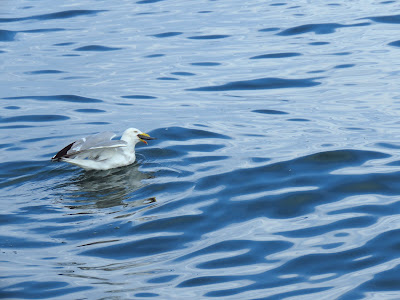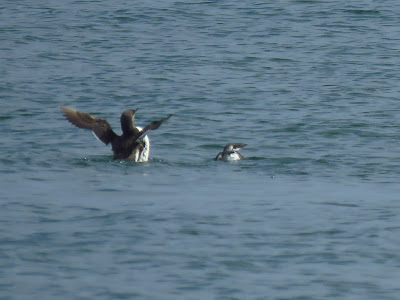I booked a Gannet cruise from the RSBP a few months ago. The Yorkshire Belle sails from Bridlington and goes around Flamborough Head to just off Bempton Cliffs. It had been a long time since I had taken this cruise and since Covid hit, I hadn't been on the Yorkshire Belle. I got there very early, 7:30, with a couple of hours to spare before coming aboard. It was cloudy but very still. It was just over a year since I visited Bridlington for my walk along Holderness, so in today's blog post I'll focus on the birds I try to see at Bridlington Harbour. Bridlington has a great assortment of urban birds, one of my favourites: Kittiwake. There are plenty of Kittiwake nests in Bridglington, the Herring Gulls prefer roofs and chimney pots but the Kittiwakes make do with window sills. Although it is late in the season and most chicks have fledged, there were some still about.
A lone chick on a shelf, next to a new nest.
This is my favourite nest, under the fierce protection of a plastic falcon/owl hybrid. It's an old nest, Kittiwakes add to their nest every year and this one looks quite tall.
Very sad to note that the colony at the Goodwins building has been cleared and the building netted to prevent Kittiwakes from nesting.
In contrast, the outer harbour wall colony was quite busy and I counted 17 young.
Next, Turnstones. Many walk around the pavements of the promenates looking for tidbits. Others are roosting on the harbour's slipway. Some adults are looking stunning in their breeding plumage. Turnstones don't breed in the UK so these must have already returned from their breeding grounds. I counted 65 Turnstones in and around the harbour.
Juvenile turnstone
The tide is still out and I have a look at the south beach. The creche of Herring Gulls is located where I saw it last year. This time there are more adults, with a separation between young and adults. The young gulls, closer to the tideline pick at the waters edge and play with various objects, one of them has picked a razor clam shell.
A Herring gull juvenile begging to its parents.
A Herring Gull juvenile resting on a slipway.
A pair of Lesser black-backed Gulls in the distance. A Knot feeds in the company of two turnstone.
Lesser black-backed gull.
There are also two
Great Black-backed gulls, my top bird to see at Bridlington. I count 10, including a few stunning adults. They are majestic, massive, powerful. Their strange, deep long calls heard regularly at the harbour. The wait on the queue of the Yorkshire Belle was made all more easy by having a GBBG sitting on a lamp post opposite it. GBBG don't breed in the area, but adults seem to be around year round.
Look at its massive head!
Long calling.
This, one taken during the trip. Often Herring Gulls got to the fish before the gannets, but if a GBBG turned up she ended up stealing it.
More long calling.
A young GBBG long-calling.
This GBBG fed on a cod's head in the harbour.
At the harbour, small parties of Sandwich Terns pass by calling noisily. In the distance, squadrons of Gannets, a flock of Oystercatchers and a Curlew. Someone complains about the 'awful' weather, and I realise that there is some sailing outing, no good to have the sea still like a lake and no wind!
The Cruise
I've done many outings with the Yorkshire Belle, a few times on the trips organised by the RSPB. In this particular one the main aim was to see diving gannets. I also held a little hope of seeing the Black-browed Albatross. We sailed with a light mist and calm seas. The RSPV volunteer called the usual landmarks of Flamborough: Sewerby cliffs, Danes Dyke, South Landing. We saw a few seals bobbing in the water near the tip of the headland.
Danes Dyke
Rock fall.
Cave formations on the north side of the headland.
Near Breil Newk I heard the call of a Peregrines and saw two together. One, a juvenile started chasing a white Feral Pigeon and carried the chase for a while along the cliffs. Eventually the pigeon escaped and the peregrine returned.
Curve strata near Staple Newk.
Gannets at Staple Newk.
It started to rain lightly. We had arrived at the cliffs by Staple Newk. The colony was pulsating with the flapping brown wings of dozens of young Gannets. The RSPB volunteer confirmed that this is a known Gannet behaviour when it rains. We scanned the cliffs hopeful for the albatross. The many young gannets made it even more difficult and it wasn't to be.
The boat moved offshore and fish was thrown onto the water. Herring Gulls were quick and gulped the large fish in seconds.
Herring Gull.
Gannet.
Eventually Gannets arrived. I noticed that they called, 'karrah, karrah, karrah!' excitely as they were about to dive, possibly a signal to alert others? Here, two gannets about to dive, the one behind calling.
Most of the dives we saw were shallow dives as the fish weren't very deep.
Gannet in flight.
We run out of fish and it was time to head back. The sun started shining. We went past groups of Fulmars.
Fulmar in flight.
Fulmars on the water.
Guillemot dad with his tiny chicks on tow, just fledged.
When we got back to Breil Newk, the captain brought the boat close to the land. We had great views of Shags.
A group of Shags.
This shag, with the green darvic, marked DAN, is probably from the Isle of May ringing scheme.
The boat made it back to Bridlington with little to report other than 5 Swallows offshore.
Once at Bridlington I had another walk around the harbour before leaving for home.
A flock of Redshank, I counted 28 arrived at the harbour and dispersed to feed.
Redshank.
The final bird of mention, Purple Sandpipers, are another Bridglington speciality. I found 3 roosting on the north sea wall in the morning, but two were feeding on the south wall in the afternoon. A non-breeding species which can be regularly be found on the outer walls of the harbour and beach.
Purple Sandpiper.
And to finish off, a Common Tern about to dive at the south beach.












































No comments:
Post a Comment